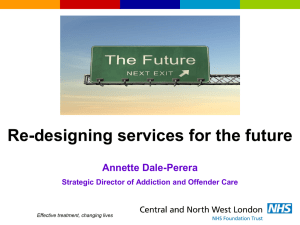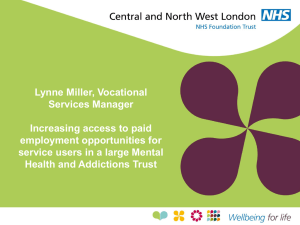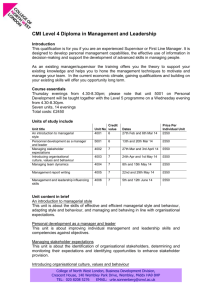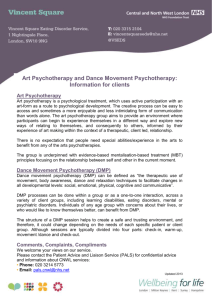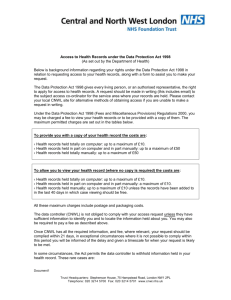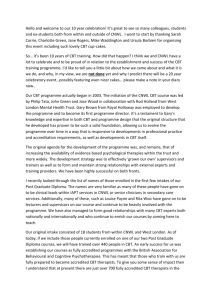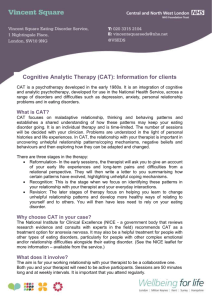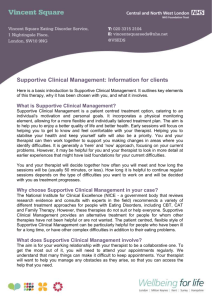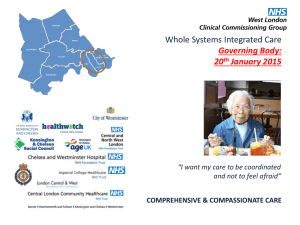Communications-and-Marketing-Strategy
advertisement
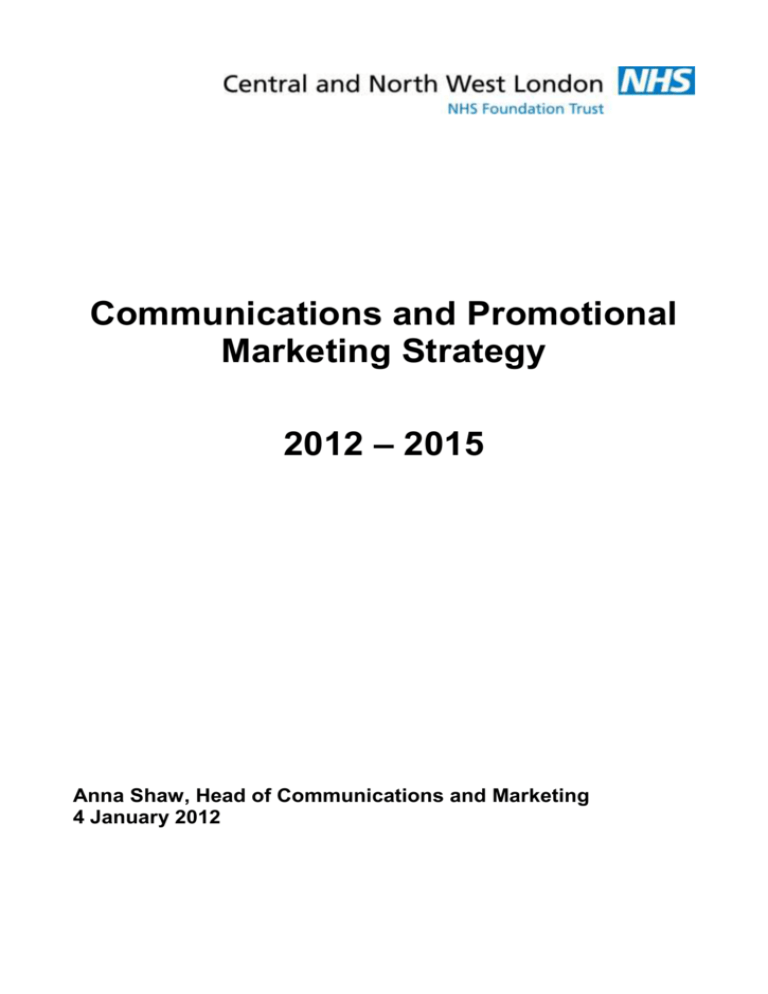
Communications and Promotional Marketing Strategy 2012 – 2015 Anna Shaw, Head of Communications and Marketing 4 January 2012 Contents 1. Introduction 2. A new vision for communications and marketing 3. Vision and values 4. Communications and marketing responsibilities 5. Communications and marketing objectives 5.1 Internal communications objectives 5.2 External communications objectives 5.3 Marketing objectives 6. Brand identity 7. Target audiences 8. Communication and marketing plans 9. Communication challenges 10. How should we communicate and engage? 11. Crisis communications 12. Promoting equality and diversity 13. Monitoring and evaluation 14. Action plan 15. Executive leads 16. Conclusion 1. Introduction This strategy focuses on the Trust’s communications and promotional marketing practices and should be read in conjunction with CNWL’s business development marketing strategy. CNWL has aspirations to grow considerably over the forthcoming years to become a larger organisation with diverse clinical services across a broad geographical area. Effective communications and marketing are essential to CNWL achieving this aim and to the future success and development of the organisation as a leading provider of high quality health care. In order to retain and diversify our business it is important that the Trust has well established and effective communication and marketing mechanisms; notably good internal and external stakeholder relationships across multiple audiences and a recognisable identity and reputation. This is particularly important in an increasingly competitive climate. Effective communications and marketing supports the delivery of clinical care and provides a number of benefits to service users across the Trust. It is also an essential tool in ensuring staff engagement and morale, particularly in times of organisational change which, for example could include further potential mergers and/or acquisitions for the Trust. As a Foundation Trust, a key stakeholder group are our Governors and members, who play an influential role within the Trust. Due to legislative changes within the NHS, it is possible that these roles may become increasingly important and powerful in the future. It is therefore vital that we have effective mechanisms, message and two way communication processes in place to share our developments and ambitions with our key audiences. CNWL is a large Trust which covers a wide geographical area. Within our catchment there are areas of great affluence alongside areas of great deprivation, which affects communication needs and approaches. With the Trust’s membership being formed from local people and services increasingly needing to market themselves to their users, language and cultural diversities as well as disability-related communication needs need to be embraced by any potential communication and marketing approaches. 2. A new vision for communications and marketing This strategy is being written at a time of great organisational change within CNWL. The Trust’s established mental health services are in the process of being realigned to embrace the principles of service line management, organising our clinical services by speciality rather than by borough. The 11 mental health and specialist service lines vary considerably in terms of their communication and marketing needs, largely in response to their requirements to attract new business and the needs of their audiences, which may be local or nationwide. Community services differ again, particularly if they are open to patient choice whereby direct marketing needs to be undertaken with potential and existing clients, to encourage their use of CNWL services. This strategy looks to implement a consistent approach to mapping and planning communication and marketing needs to address the varied needs of our clinical services. Each service line currently has a standard offer of a bespoke communications and marketing plan, a dedicated microsite with URL and a visual identity developed within the CNWL brand. Individual requirements are explored as part of the communications and marketing plan to ensure that service specific needs are addressed. Alongside this major change programme, the Trust recently increased in size through the integration of two local community provider services – Hillingdon Community Health (HCH) and Camden Provider Services (CPS). These developments change the fundamental nature and identity of the organisation as it develops and diversifies, whilst providing a new requirement for enhanced communications and marketing across numerous service areas, identities and staff groups. This strategy aims to bring together all communications and marketing mechanisms across CNWL, to ensure a collaborative approach in order to further strengthen and develop the reputation and brand awareness of the organisation and the services we provide. 3. Vision and values It is vital that all messages communicated on an internal or external basis echo the Trust’s vision and values. This set of high level messages will be core to all communications and engagement techniques. However, they will be tailored to meet the needs of specific audiences and also adapted to communicate specific developments and/or activities. Particular communications and engagement techniques will be undertaken in order to promote these messages and objectives to our core audiences. This will be undertaken on an ongoing basis, but will also form part of the Trust’s brand development work. In order to widely communicate the goals to all members of CNWL staff, as part of the induction programme each employee is given their copy of the CNWL Staff Charter, which contains these key messages. Wider promotion has also been undertaken to launch the vision and values with existing staff, through the promotion of the Trust’s new brand identity. CNWL’s vision: “We work in partnership with local people to improve their health and wellbeing. Together we look at ways of improving an individual’s quality of life, through high quality health care and personal support.” CNWL values: Dedication We empower people to improve their overall quality of life, live independently within their communities and understand how to manage any long-term health conditions. Empowerment We will involve people in their care plan and treatment, working together and alongside carers and families to create practical solutions that meet individuals’ needs. We will give our staff the support and opportunities they need to grow and develop. Partnership We believe in working together, both within our organisation and externally with our partners. We listen to, communicate with and work effectively with our partners, for example GPs, NHS Clusters and voluntary organisations etc. Diversity We value the diversity of the people we support and our staff. To create a respectful and supportive working environment, we will take the time to communicate clearly, ensuring that everyone understands one another and feels included. Whilst messages will be shaped in order to respond to the subject being discussed, all messages should reflect the strategic vision and values of the Trust. 4. Communications and marketing responsibilities In November 2009 the Department of Health published The Communicating Organisation: Using communication to support the development of high-performing organisations. It highlighted the research which states that better-performing Trusts committed more resources to communication, were more likely to have marketing strategies in place and had communications teams that were more influential. It also found that staff in Trusts rated as ‘excellent’ were significantly more likely to understand their roles than those in weak-performing ones. The document goes on to identify ‘what good looks like’ in terms of communications. Work at the Centre for Public Relations Studies at Leeds Metropolitan University led to the following four attributes: An excellent understanding of the brand Excellence in planning, managing and evaluating communication Leadership support for communication Communication as a core competency. These attributes should be applied across the following four perspectives: Societal – how the NHS is perceived as a whole at national and local levels Corporate – how communication operates within each organisation at the level of strategy setting Service user and stakeholder – an understanding of how patients and the public experience the NHS locally Functional – the way in which communication strategies and programmes are put into action. Benefits that come from these attributes applied across the four perspectives will tend to see the following results: Improved trust, legitimacy and reputation with the local community Informed business decisions, better equipped senior managers and good stakeholder networks Services that uphold the brand, are informed by the needs of its users and are supported by engaged stakeholders A communications department that performs an effective and functional role in a focused and informed organisation. This strategy aims to deliver the attributes outlined above, in order to enhance the work of CNWL by benefitting from the results outlined above. 5. Communications and marketing objectives Communications can be defined into two areas, that of external communications and internal communications, both of which form an important part of delivering high quality care and meeting the business/commercial needs of the organisation. Marketing practices are closely aligned to the Trust’s external communications mechanisms yet have a distinct business objective to ensure services are appropriately marketed in order to retain contracts and support the organisation to develop and diversify, as outlined in the Trust’s business development marketing strategy. 5.1 Internal communications objectives Effective internal communication is vital for the successful functioning of any organisation. Communication and information affects the quality of all professional relationships and CNWL needs to ensure that its staff, contractors and partner organisations are well informed. Staff engagement in an organisation is often hard to measure, yet research has shown that an engaged workforce is more productive and shows better recruitment and retention rates than staff who are not engaged. To date staff survey results reveal CNWL performs well in relation to staff engagement and this is an established component of the Trust’s communications team’s work. The Trust has an established strapline, vision and values that can be adapted and communicated to all audiences. For this information to be fully disseminated and become the corporate identity for the Trust on both an internal and external basis, it is vital that all internal stakeholders understand the overall aims and objectives of the Trust and how their role forms part of one larger structure. Good internal communication at all levels in turn supports service planning and development, recruitment and retention of staff, and leads to a feeling of empowerment in staff, improving motivation and staff morale. The Trust’s internal communications objectives are: To ensure staff are well informed about news, developments and any changes taking place within the Trust To ensure staff are given the opportunity to voice their opinions, put forward suggestions for Trust development and engage in two way communications To ensure staff opinions are fed back to the Trust’s senior managers and are acknowledged To ensure that staff are well informed of the range of opportunities available to them throughout the Trust To ensure staff receive recognition throughout the Trust for personal and departmental achievements and increase staff morale To ensure that staff understand how their work fits within the overall aims and objectives of the organisation To ensure that members of the Board of Directors and Executive Team have a visible presence and regularly engage with staff To promote the role of staff as members of the Trust To ensure staff have an awareness and understanding of how the Trust’s Communications and Promotional Marketing Strategy can be used to disseminate information across a range of different sites and to raise the profile of the organisation locally, nationally and internationally To ensure staff are aware of the role of the communications and marketing team and how the team can help to promote their work. Ways in which we can achieve these objectives are outlined in the action plan for the communications and marketing team. 5.2 External communications Effective external communications mechanisms are increasingly important to the needs of CNWL as an organisation looking to grow and diversify its services. We need to establish new, positive relationships and communication channels with new audiences, whilst also keeping our current stakeholders informed of our developments and the motivation behind them. This will in turn support the developing reputation of the Trust and its services. The Trust therefore needs to ensure that our commissioners, partners, the media, our patients, members and the public and all external contacts are well informed and that we have processes in place to identify new and emerging stakeholders and direct appropriate communication streams to them. Good communication at all levels supports patient care and satisfaction, together with public recognition of the health issues faced by the local community and the achievements and positive developments taken by the Trust. The Trust also works to communicate important developments and successes with local external audiences, in order to improve public awareness and recognition of CNWL. Through regular contact and collaboration with local press and media, the Trust needs to ensure regular proactive and positive coverage together with ensuring prompt and accurate responses are given to press enquiries and external requests for information. The Trust’s external communications objectives are: To ensure all Trust representatives give consistent messages about the work, aims and objectives of CNWL to all stakeholders, promoting the Trust’s strapline of ‘Wellbeing for life’ and the associated vision and values To enable effective two way communication with external stakeholders and encourage external stakeholders to comment on proposed developments and take an active involvement within the Trust To ensure that our external contacts are well informed of the work and the climate we work within and that good communication links are established and maintained To ensure CNWL’s commissioners are actively engaged and informed, developing relationships that will retain and generate new business opportunities To effectively market the Trust to improve local awareness of what CNWL does and the services it offers To effectively market the Trust so CNWL services are seen by patients as being high quality and attractive options to select when offered a choice of provider To strengthen existing relationships with local and national newspapers, radio and television To ensure positive news and features are released regarding the work of the Trust and the people who work within it, to enhance and protect the reputation of CNWL To respond promptly and accurately to press and media enquiries To produce effective and meaningful patient information To undertake effective communication to involve and consult patients and the public in the planning of services and regarding any potential service changes (in line with Section 242 guidance. Ways in which we can achieve these objectives are outlined in the action plan for the communications and marketing team. 5.3 Marketing Through its business development strategy, CNWL has committed to ongoing expansion, taking advantage of business opportunities in order to further develop and diversify as an organisation both in unfamiliar areas and through unfamiliar services. There may be direct opportunities for this as part of the national changes to the NHS, namely through acquisition of organisations that do not gain Foundation Trust status, and also via new contracts that are open for tender, where the Trust would seek to win new business from competitor organisations. It is important that the Trust’s promotional marketing covers the following elements: Marketing of existing services – supporting services lines to retain and win new business within their own fields of expertise Marketing of the Trust overall – ensuring that CNWL is well known and recognised as a leading provider of a wide range of health care services. This applies to a variety of audiences, including new relationships for example with GP commissioners. Business to consumer marketing – ensuring effective marketing and promotion is undertaken at a local level to ensure local people choose to use CNWL services (for the Trust’s patient choice services). The Trust’s promotional marketing objectives are: To develop and implement the new CNWL brand, ensuring consistency and continuity of all materials produced by CNWL to ensure a clear brand identity is created. To support the Trust’s service lines in developing marketing plans, which support the aims and objectives of their business cases. To develop a range of promotional tools to support the reputation of CNWL at key events and engagement opportunities. To develop an effective directory of services to support key teams within the Trust that seek new business opportunities. To develop and launch a new CNWL website to act as a key marketing tool, with associated SEO (search engine optimisation), e-marketing and social media. To make effective use of a CRM (customer relationship management) database to map and monitor engagement with external stakeholders. To profile our stakeholders and ensure we have relevant, regular contact with the right people To explore the use of social marketing, in particular in relation to the Trust’s choose and book services and anti-stigma campaigns. To work in partnership with the Trust’s Business Development Team to ensure a consistent and joined-up approach. Ways in which we can achieve these objectives are outlined in the action plan for the communications and marketing team. 6. Brand identity CNWL has recently launched a new brand identity, which is in the process of being rolled out across materials produced by CNWL, including HCH and CPS. The brand, which is centred on the core theme of communication, dialogue and engagement, followed a detailed brand analysis, which highlighted key perceptions and beliefs about CNWL as an organisation across our numerous stakeholders. The aim of the brand is to ensure all materials produced by CNWL are corporate and consistent, and recognised as belonging to CNWL. This in turn supports the reputation of CNWL and helps to aid identification of services belonging to the CNWL family. A focus for the Trust’s brand identity is to roll the brand out across HCH and CPS to ensure their services become recognised as being CNWL. This is particularly important given the existence of separate organisational names, which are still in use. Internally within CNWL there are services that have developed used individual names (i.e. Brent Mental Health Services, the Marlborough) which some stakeholders assume to be an organisational name rather than part of CNWL. This could be perpetuated by the creation of service lines as mini businesses, and clear guidelines about the use of names other than CNWL need to be agreed. Areas for consideration include: Future use of organisational names and logos across CNWL’s mental health and community services Development of an online brand identity to be used across all CNWL websites and microsites An agreed focus to embed the brand across the Trust and its services. All branding work needs to be in line with the NHS Identity Guidelines and guidance is available on how this is to be achieved, including use of the Trust logo. A number of branded templates are available for teams to use, underpinned by a Policy for Producing Patient Information, which supports this strategy. 7. Target audience It is important to shape communications and marketing activities in response to the audience being targeted as each group will have different needs that can vary. The Trust’s Good Communications Guide, which supports this strategy, contains more guidance on issues that should be considered when assessing how to communicate with each audience: 8. Communications and marketing plans A process for developing communications and marketing plans for specific developments, projects and/or announcements is now in use throughout the Trust. This includes an agreed template that outlines key messages, activities, risks and an action plan for developments taking place across the trust. An integral component of the plan is also a stakeholder mapping exercise, which identifies the power and influence of key groups affected by the development or project. This directly influences the mechanisms that will be undertaken and the associated action plan. 9. Communication challenges The process for developing a communications and marketing plan, as outlined in section 8 of this document, identifies challenges and potential red flags for developments that are taking place across CNWL and puts plans in place to ensure any potential risks are minimised. However, there are some overarching communication challenges that arise across the organisation. The following issues need to be explored when undertaking any communications and/or engagement activities: The wide diversity of local audiences Language Different formats e.g. large print, Braille, or Easy Read, BSL. Managing the message appropriately across different audiences Current level of brand awareness Whether the information is part of a wider, national or even local message Whether there are strong local feelings on the issue that need to be addressed/overcome If the news is of media interest If a willing audience is being communicated with. The Trust’s Good Communications Guide contains more guidance on communication challenges, considerations and how they can be overcome. 10. How should we communicate and engage? Communications is everyone’s responsibility and each member of the Trust has a role and responsibility to support good communications with service users, carers, members of the public, partners and colleagues. In line with NHS guidelines all communications are required to be based on the following principles: Clarity of message – We should consider what we are saying, how it is best to say it and the potential impact of any message. Timeliness – Our staff, public, patients and partner organisations should hear news from us first, where possible and practical. Accuracy – We must always be 100% accurate if we are to remain a trustworthy and reliable source of information. Honesty – There are some things that are too sensitive or too personal to share publicly, or they may be covered by patient confidentiality. We must say so if this is the case. However, most things we do can and should be shared, including bad news. Engagement – All communication should be two way – top down and bottom up – and we must ensure there are mechanisms in place to achieve this. 11. Crisis communications The Head of Communications and Marketing/deputising Communication Managers must be informed of any crisis situation that is likely to attract media attention so that it can be dealt with professionally. The Head of Communications and Marketing/Communications Managers will liaise with communications leads at NHS London (Strategic Health Authority) regarding any crises or negative national press coverage. In the case of a major incident, the emergency plan should be put into action, whereby the communications lead is responsible for working with the Major Incident Team (MIT) to perform a number of key duties. The Trust is liable for the health and welfare of its population and the safety of its staff, and also, under the Civil Contingencies Act for public awareness; warning and informing the public in order to minimise the impact of the emergency on the community, including pre-event, during an event, and immediately and long-term post-event. Recommendations for communications and emergency planning are included in the Communications and Marketing team action plan and are supported by the CNWL media handling policy. 12. Advancing equality and diversity We are aware that CNWL covers a range of diverse and vibrant communities. In order to engage with the widest possible range of people and ensure that this is undertaken in an effective and meaningful manner, we will need to employ a variety of approaches and mechanisms, including greater use of digital technologies. Key issues that will be considered in order to achieve this wide ranging engagement include: Languages and formats – information will be kept as precise and simple as possible. All written information produced by the Trust will also be available in different languages and formats on request. Targeted approaches – communications and engagement materials will be adapted to the needs of particular local communities and where appropriate will build on specific cultural references in order to best share the message being given Imagery – all Trust documentation containing images of people should be representative of diversity across the ‘protected characteristics’ as defined by the Equality Act 2010 Easy read – as a Trust providing learning disability services, it is important that we embrace the principles of easy read into our publications and printed material. Over the forthcoming years the Trust will be working to achieve this standard, and ensure that the materials we produce are accessible to those with a learning disability. 13. Monitoring and evaluation Implementation plan This strategy will be implemented over the forthcoming three years. The communications and marketing team will hold an annual action plan that meets the strategic aims and objectives of this strategy. This annual plan will outline key actions and areas of development together with corresponding to the appropriate Trust strategic aim. Progress towards these actions will be monitored on a regular basis. Risk assessment Any risks to achieving the aims of this strategy will be raised and, if appropriate, recorded on the directorate risk register. Adherence to this strategy aims to minimise risks that could potentially arise throughout communications and marketing activities e.g. risks to the overall reputation and brand of the Trust. Individual communications and marketing plans will be produced for key areas of work. This will also minimise any potential communications and marketing risks to the organisation. Evaluation The Communications and Marketing Strategy will be reviewed every three years and adapted to meet any new challenges facing the organisation. Action plans will be updated on an annual basis. Separate evaluation activities will be undertaken for particular areas of work, via the communications and marketing plans. There are a number of key indicators which will imply successful implementation of this strategy, including: Increased business – the Trust successfully winning new tenders and business opportunities, resulting in organisational growth and increased income/profit Increased business through our service lines – winning new contracts, retaining existing work, working closer to capacity Increased positive media coverage and opportunities about the Trust and the work it undertakes, thereby improving our profile and reputation Improved brand awareness – through undertaking a repeat brand audit with stakeholders Increasing number of hits to the CNWL website Positive participation and conversation through social media networks Improved staff and patient survey results Increasing rates of staff retention Use of new communications mechanisms e.g. YouTalk. These indicators will be monitored and audited as appropriate over the next three years. 14. Action plan A detailed action plan sits alongside this strategy, which summarises ways in which the objectives of this strategy can be met. It outlines the tasks required by the communications and marketing team and places timescales and personnel requirements against the recommendations made in this strategy. This will then be supported by further development of the team, subject to additional investment being identified by the executive team. 15. Executive leads The Board lead for communications and marketing is the Director of Strategic Development and Community Services. 16. Conclusion It is vital that effective communications and marketing mechanisms are developed across CNWL to ensure the Trust is effectively responding to the needs of the organisation in terms of its growth and future stability as a leading provider of NHS services. Whilst CNWL has a long way to go in terms of communications and marketing in comparison to many of its competitor organisations, there is great potential and appetite to develop this area of the Trust. When delivered successfully, meaningful communications and marketing techniques can have a great impact in delivering the aims of the Trust’s strategic plan and the overarching aims. By adhering to this strategy and its accompanying future action plans, the Trust will ensure that CNWL service users, commissioners, referrers, staff, residents and other stakeholders receive clear and consistent messages, which will be clearly identified as coming from the Trust.
